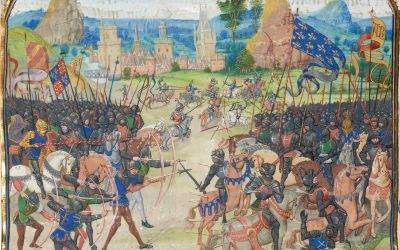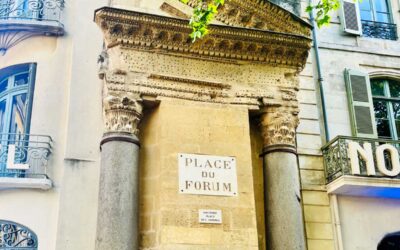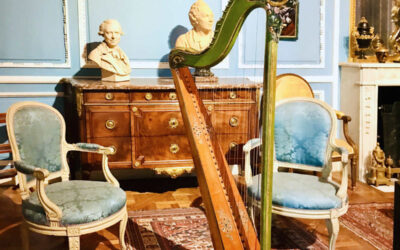Since the days of the first metro lines in Paris, those wide open doors of the carriage trains have always attracted the crowds. The Paris metro is second busiest metro system in Europe, after the Moscow Metro, and has become a symbol of the city.
The metro network plays an important role in this densely compact city’s lifeblood, as it provides transport all hours of the day and late into the night.
Whether it is tourists shuttling about between the Eiffel tower and the Louvre museum, or locals travelling between work, play, and home, the easiest way to get around Paris these days is the metro.
Paris is clogged with cars and traffic jams are common, making the metro is a cheap and easy way to get around town. (Excluding the dreadful accessibility issues the Parisian metro suffers from which we will discuss later!)
If you walk around the metro in Paris, you will signs for RATP everywhere, which is the state-owned public transport company that operates the metro, for better or for worse. It stands for Régie Autonome des Transports Parisiens (meaning “Autonomous Parisian Transportation Administration”).
So let’s cover some interesting facts about the Paris metro and how Parisians really feel about it, shall we? Allons-y!
- 1. The Metro began operation in 1900.
- 2. Metro stations around Paris: 304 and counting.
- 3. Stations are an average of 550 yards away from each other.
- 4. Depth of the trains and metro
- 5. Metro stations named after famous people
- 6. Stations named after French battles
- 7. Pickpockets and safety in the Metro in Paris
- 8. Accessibility is very poor.
- 9. Metro stations named after writers
- 10. Metro Rambuteau is named after a government official who transformed Paris.
- 11. Quatre September Metro station refers to a date even most French don't remember.
- 12. The tunnels were used by the French Resistance to plan and carry out attacks during WWII.
- 13. Arts et Métiers station is designed to look like a submarine.
- 14. Louvre-Rivoli station has replicas of ancient treasures on display.
- 15. Bastille station has revolutionary paintings on the wall.
- 16. Several ghost metro stations haven't been used in years.
- 17. Musicians need a permit to play in the metro.
- 18. Metro stations named after inventors
- 19. Line 7bis is very political.
- 20. Porte de Lilas is used as a movie set.
- 21. Metro Concorde represents the 1789 Revolution.
- 22. Some metro stations are in a flood zone.
- 23. Line 1 follows the Axe historique of Paris.
- 24. Parisians avoid Line 13.
- 25. Châtelet Les Halles is one of the biggest metro stations in the world.
- 26. Metro stations named after former towns
- 27. There are 27 metro stations named after saints.
- 28. There are 2 stations named after Michelangelo.
1. The Metro began operation in 1900.
The first metro trains began running on 19 July 1900, during the World’s Fair (Exposition Universelle) that was held in Paris.
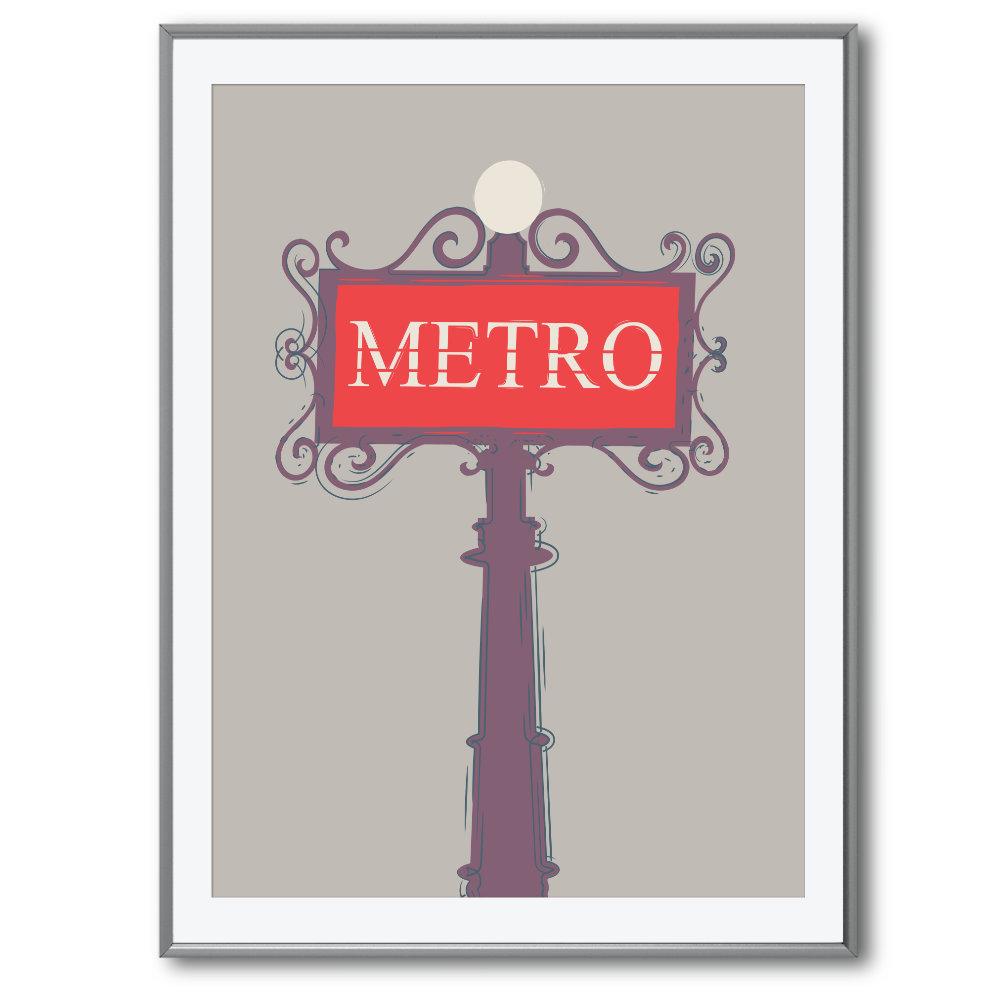
Because Paris is an old city where extensive labyrinths and catacombs already exist under the city, it was relatively easy to dig new tunnels. It is the 6th oldest metro in the world after:
- London Underground in 1863
- Istanbul Tunnel in 1875
- Chicago ‘L’ in 1892
- Glasgow Circular Underground in 1896
- Budapest’s historic metro line in 1896
The train network in Paris expanded quickly until World War I and the main stations within the center were complete by the 1920s.
Chemin de fer – Railroad
French-English translation
The original name of this Parisian institution was La Compagnie du chemin de fer métropolitain de Paris (“The Paris Metropolitan Railway Company”), which gradually shortened down to métro and became a term used all over the world.

2. Metro stations around Paris: 304 and counting.
There are currently 304 stations over 16 metro lines scattered in and around Paris, and more are expected. Four more metro lines are in the works, with several additional stations that are expected to see the day between 2024-2030.

3. Stations are an average of 550 yards away from each other.
Paris intra muros is quite small in size, and metro stations in the city are are quite close together. In the dense center, stations are often within 550 yards (500 meters) from one another, making it often easier to just walk between stations rather than go underground.
It is estimated to take around 1 minute to get from one station to the other on the metro.
4. Depth of the trains and metro
The Paris metro is not very deep, with many stations a mere 20 feet underground. The deepest metro station is Abbesses at 118 feet (36 metres) underground.
And in fact, not all of the Paris metro is underground. Metro lines 2 and 6 have a lot of stations that are above ground at the 2nd-3rd floor level or above, to fly over car and pedestrian traffic.
5. Metro stations named after famous people
The French love to name metro stations after famous people, most of whom have to do with the wars that France has been involved with. Here are the most notable, by metro line:
On Metro Line 1:
- Charles de Gaulle Etoile – General Charles de Gaulle, leader during WWII, and future President.
- Franklin D. Roosevelt – American President during WWII.
- George V – King George V of the United Kingdom during WWI.
- Champs Elysées Clemenceau – French Prime Minister Georges Clemenceau during WWI on the famed Champs Elysées.
On Metro Line 2:
- Colonel Fabien – French resistance leader during WWII killed at age 25.
- Philippe Auguste – French King Philippe Auguste (1165-1223) who fought the Plantagenets on the English throne.
- Pigalle – Jean-Baptiste Pigalle, an 18th century French sculptor.
On Metro Line 3:
- Gallieni – named after French General Joseph Gallieni. He famously commandeered over 600 taxi cabs to take troops to the front to protect Paris from German invasion during the 1st Battle of the Marne in 1914 during WWI.
On Metro Line 4:
- Denfert-Rochereau – French Commander Pierre Philippe Denfert-Rochereau, who defended the area against the Prussians (Germans) who had besieged Paris in 1871.
On Metro Line 9:
- Chaussée d’Antin – La Fayette – After Marquis de Lafayette, hero of both the American and French revolutions.
- Robespierre – named after Maximilien de Robespierre (1758 – 1794), who was one of the best-known leaders of the French Revolution.
6. Stations named after French battles
Keeping with the war theme, several metro stations are named after famous battles in French history:
- Stalingrad (Line 2) – Named after the Battle of Stalingrad in 1943, when Russia and her Allies defeated the German Reich during WWII. It was one of the bloodiest battles in the history of warfare, with an estimated 2 million total casualties.
- Bir-Hakeim (Line 6) – Named after the Battle of Bir Hakeim which took place during WWII in Libya in 1942. The 1st Free French Brigade under Général Kœnig defended the position for several days showing that the French Resistance were able to deploy and fight alongside the U.K. and her allies against the German Reich.
- Liège (Line 13) – When this metro station first opened in 1911, it was called Berlin. But after WWI, it was renamed Liège in solidarity with struggle of the Belgian city against the German invasion that was taking place at the time.
- Solférino (Line 12) – Named after the city of Solférino in Italy where a battle which took place in 1859 which resulted in a French victory.
- Anvers (Line 2) – Known as Antwerp in the Flemish language, it is named in tribute to the French victory against the Dutch occupiers during the siege of the Belgian city in 1832.
- Alma – Marceau (Line 9) – The 1854 battle of Alma in which the French-English-Ottoman allies defeated the Russians. The bridge to cross the Seine that was completed two years later was named Pont de l’Alma, and later gave its name to the metro station.
- Gare d’Austerlitz (Line 5) – Battle of Austerlitz which was also known as the Battle of the Three Emperors. In what is perhaps the greatest victory by Napoleon Bonaparte, France defeated a larger Russian and Austrian army led by Emperor Alexander I and Holy Roman Emperor Francis II.
- Buzenval (Line 9) – This is where the Battle of Buzenval of the Siege of Paris, part of the Franco-Prussian War took place on 19 January 1871.
- Iéna (Line 9) – the French name of Jena where the Napoleon’s army defeated Prussia in 1806 at the Battle of Jena.
7. Pickpockets and safety in the Metro in Paris
The reality of living in Paris is that you do have to keep an eye on your things to prevent pickpockets. This is especially the case in the crowded metro.
As such, the Paris Metro regularly sounds warnings to tourists about watching your stuff in French, English, German, Spanish, and Japanese.(If you are a woman, I highly recommend a cross-body purse with zippers that you can easily access while out and about.)
8. Accessibility is very poor.
With lengthy stairways, a lack of elevators, escalators that often don’t work, and large gaps between the platform and the trains, the Paris metro rates very poorly on accessibility.

Only 3% of the metro is considered wheelchair accessible, compared to 20% in London, and 24% in New York. (Most locals with children in strollers or luggage avoid the metro.)
Paris’s bus network above ground is considered 90% accessible, but it is slow and often stuck in traffic jams.
9. Metro stations named after writers
Several metro stations are named after famous French writers including:
- Alexandre Dumas (line 2) – French author Alexandre Dumas of 3 Muskateers fame and other novels.
- Victor Hugo (line 2) – French writer and politician. Famous books included of Hunchback of Notre Dame and Les Miserables.
- Voltaire (line 9) – French writer and philosopher who was one of the key voices of the 1789 French Revolution and an outspoken advocate of civil liberties.
10. Metro Rambuteau is named after a government official who transformed Paris.
Just 40 years before the 1st metro was inaugurated in Paris in 1900, the city was undergoing a massive transformation.
An architect named Baron Haussmann was hired by Emperor Napoleon III to raze much of the city to the ground (over 60%) and reconstruct the Paris in the Hausmannian architecture that we see today.

While Haussmann was disliked and did not get a metro station named after him, a government prefect named Claude Barthelot, the Comte de Rambuteau who established the groundwork for this transformation, is honored at Metro Rambuteau on line 11.
11. Quatre September Metro station refers to a date even most French don’t remember.
The Quatre-Septembre station refers to September 4, 1870, the day of the proclamation of the Third Republic. In essence, France went through several revolutions, changes of government, and even a coup d’etat.
The French 3rd republic lasted from 1870 to 1940 when WWII started. With 2 more Republics after that (we are currently in the 5th republic) most Parisians will be hard-pressed to remember what “4 September” refers to.
12. The tunnels were used by the French Resistance to plan and carry out attacks during WWII.
During WWII, cars and taxis were greatly reduced in Paris, making the population dependent on the metro. With crowded platforms and trains, the metro became the ideal place for the French Resistance to hide and plan their attacks.
Thousands of incidents were noted in and around the metro during the German occupation of Paris, including attacks, sabotages, bombs exploded, breakdowns caused, brakes disconnected, etc.
13. Arts et Métiers station is designed to look like a submarine.
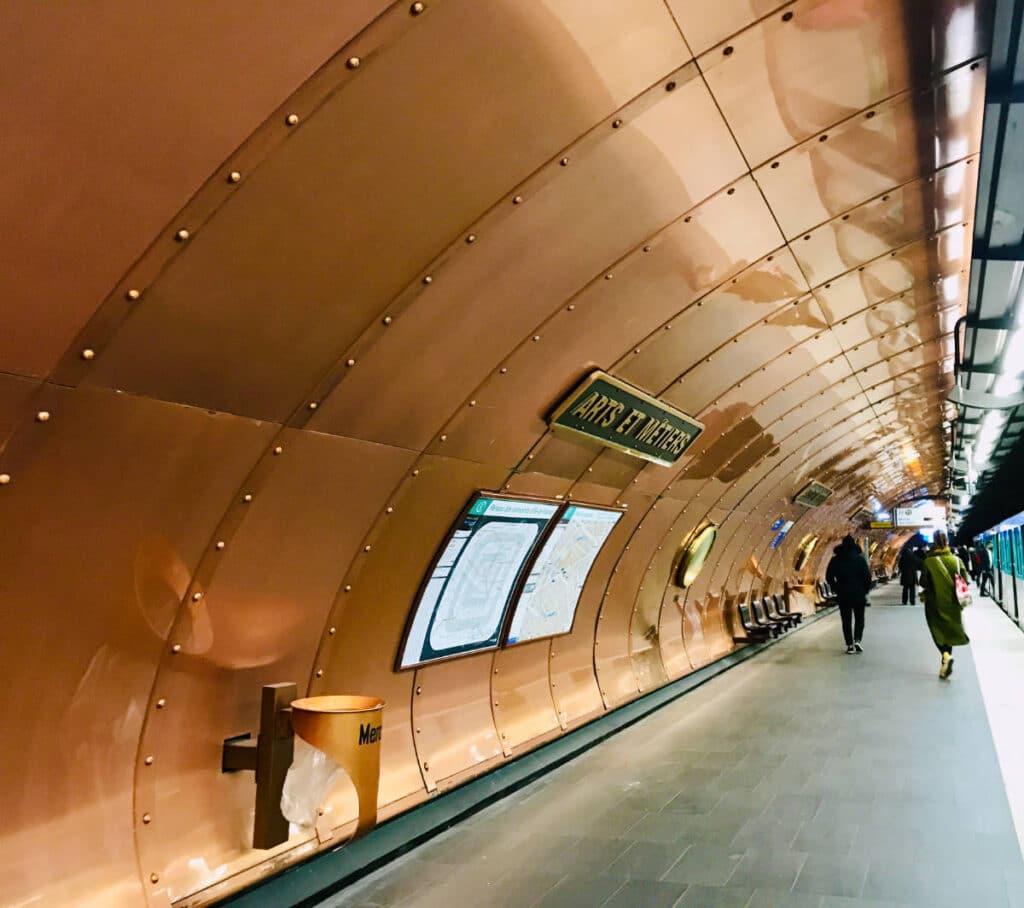
For the 200th anniversary of the Conservatoire national des arts et métiers that is nearby, the Metro Arts et Metiers was made to look like a submarine out of a Jules Verne novel.
The nearby Arts et Metiers Musée traces the footsteps of French inventors and engineers and is well worth a visit.
14. Louvre-Rivoli station has replicas of ancient treasures on display.
The Louvre-Rivoli metro station took years to renovate, but when it finally finished it was worth the wait.
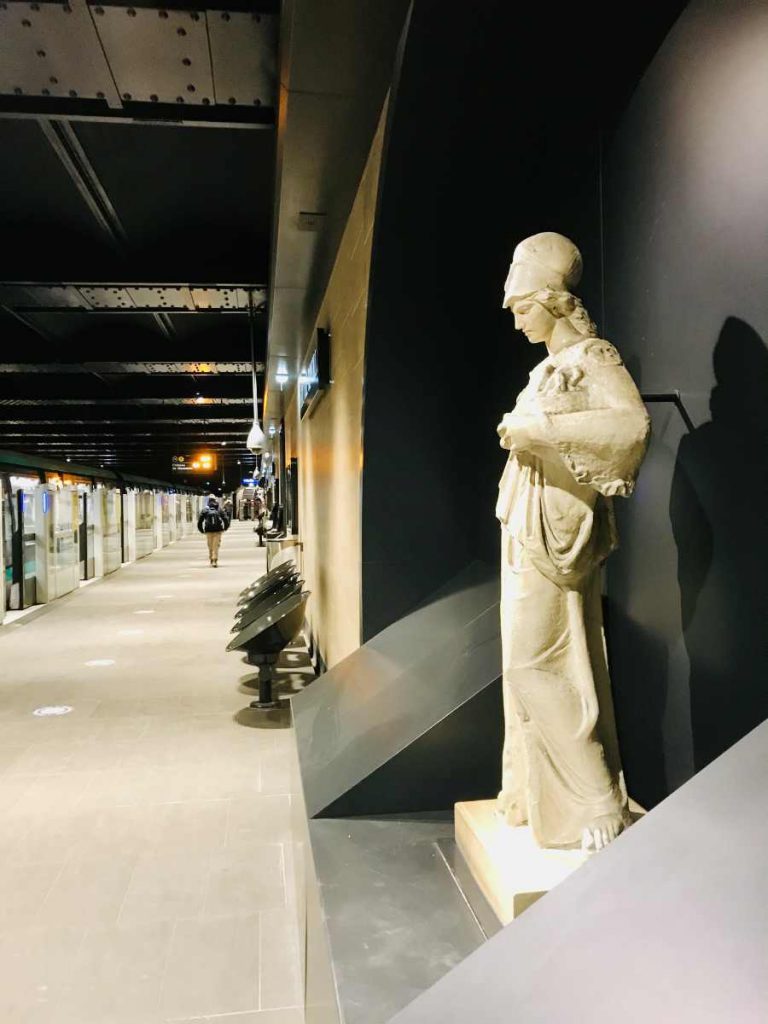
Replicas of famous treasures like Venus de Milo and Code of Hammurabi were placed in the metro, bringing a bit of the Louvre museum down into Paris’s underground.
15. Bastille station has revolutionary paintings on the wall.
The prison fortress at Place de la Bastille may no longer be standing after the storming of the Bastille on July 14, 1789, but the metro station Bastille honors that seismic event with tile murals showing the Parisian revolt.

The Bastille station is rather large, so if you are looking for it, it is on the platform of Metro Line 1.
16. Several ghost metro stations haven’t been used in years.
The Paris metro was built so densely close together that there are several stations that have been abandoned for not being useful. These ghost stations as they are called, include:
- Croix-rouge
- Saint Martin №1.
- Saint Martin №2.
- Arsenal
- Champ de Mars (now used for RER trains)
- Haxo Station
17. Musicians need a permit to play in the metro.
The Espace Metro Accords (EMA) was created in 1997 to decide which musicians can play their music in the metro. It holds annual auditions with 350 candidates selected each year.
18. Metro stations named after inventors
There are several metro stations named after France’s famous inventors including:
- Télégraphe (Line 11) – After Claude Chappe who lived here and invented an early form of the telegraph.
- Pasteur (Line 6) – named after French chemist Louis Pasteur who formulated the principles of vaccination and pasteurization.
- Pierre et Marie Curie (Line 7) – Nobel prize winners for the discovery of radioactivity.

19. Line 7bis is very political.
Line 7bis (meaning Line 7, the addendum) is named after several socialist politicians and freedom fighters:
- Jaures – named after French Socialist politician, Jean Jaures (1859 – 1914) who was assassinated on the eve of WWI. It was believed that he would have been able to avoid the war, had he not been assassinated.
- Louis Blanc – named after French Socialist politician Louis Blanc (1811 – 1882) who favored reforms to guarantee employment for the urban poor.
- Botzaris – named after Greek Markos Botsaris (1788 – 1823), a hero of the Greek War of Independence against the Ottoman Empire
- Bolivar – named after Venezuelan President Simón Bolívar (1783 –1830) who fought for the freedom of several South American countries.
20. Porte de Lilas is used as a movie set.
With Paris being a popular backdrop for TV shows and movies like Amelie, Da Vinci Code and Midnight in Paris, there were always going to be scenes shot in the metro.
For proper shooting conditions, the Porte de Lilas metro station has an unused platform that is often used as a backdrop for French movies. The RATP will make trains available along with a driver to run the trains as necessary (for a fee, of course).
If you are in Paris for Journée du Patrimoine, you can visit the movie set…which actually just looks like the metro.
21. Metro Concorde represents the 1789 Revolution.
The Metro station Concorde has is right above Place de la Concorde, which is where Marie-Antoinette and King Louis XVI (along with many other people were guillotined.
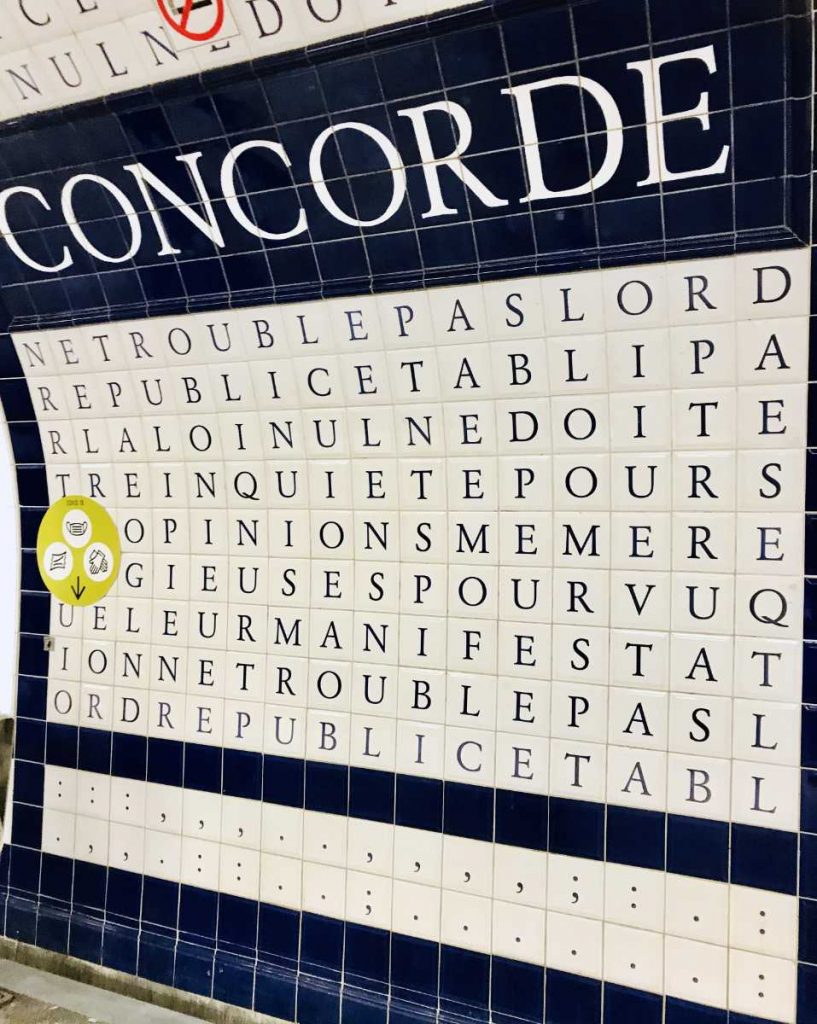
So in keeping with the theme, the metro station has a word search puzzle on the walls with phrases from the French Déclaration des droits de l’homme (meaning “Declaration of the Rights of Man”).
22. Some metro stations are in a flood zone.
Much of Paris along the quays of the Seine river are considered to be in a flood zone. There have been several large floods in the metro, with one of the most recent ones being in 2018.
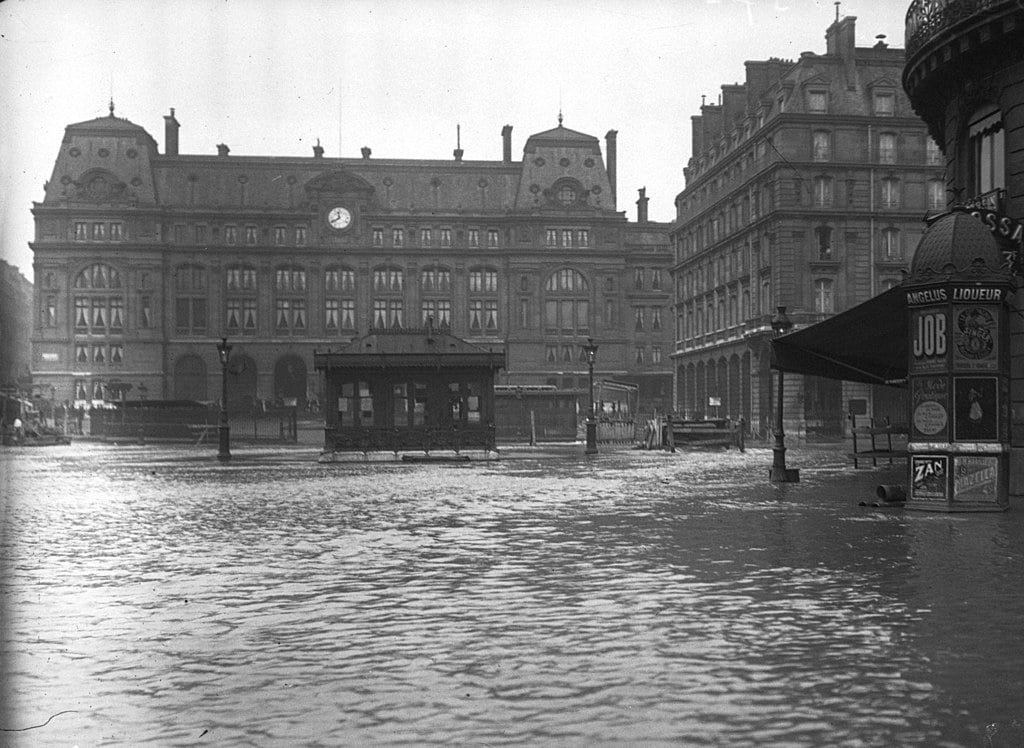
The biggest one however was the flood of 1910 when the waters of the Seine rose over 8 meters!
23. Line 1 follows the Axe historique of Paris.
Line 1 that stretches from East to West follows the Axe historique de Paris based on the old Voie Triomphale. Stretching from Chateau de Vincennes to La Défense, this metro line remains within walking distance of many of the major historic sights of Paris.

Even Notre Dame de Paris which is not shown above as it has its own metro station, is only a few hundred meters from Metro Line 1.
24. Parisians avoid Line 13.
Along with Line 1, Line 13 is one of the busiest in Paris. However, unlike Line 1, it is not yet renovated and rather cramped, making it the train that Parisians try to avoid.
The line is so overcrowded the RATP uses “pushers”, employees whose job it is to push people into the trains during rushhour. Unlucky n° 13.
25. Châtelet Les Halles is one of the biggest metro stations in the world.
Located in the center of the city, Châtelet Les Halles is one of the biggest metro stations in the world. It connects no less than 5 different metro lines and 3 RER train lines.
It is located on the site of the Grand Châtelet , a former fortress which served as a prison and court under the Ancien Régime, before being demolished in 1802 during the reign of Napoleon Bonaparte.
There are portions of it that always seem to be under construction, and it is so large it can take a good 5 minutes to walk from one train line to another.
26. Metro stations named after former towns
As Paris was expanding, it absorbed smaller communes and towns that were originally in its outskirts.
In 1853, eleven municipalities bordering the old city of Paris were eliminated and absorbed into the city, including Belleville, La Villette, Passy, Batignolles-Monceau, Bercy, La Chapelle, Charonne, and Montmartre. You may recognize these names now as metro stations around Paris.
27. There are 27 metro stations named after saints.
France may hold the concept of laicité close to its heart (meaning “the separation of church and State” ), but there are 29 Paris Metro stations that are named after French saints:
- Basilique de Saint-Denis on Line 13
- Boulogne – Pont de Saint-Cloud on Line 10
- Cour Saint-Émilion on Line 14
- Mairie de Saint-Ouen on Lines 13,14
- Porte de Saint-Cloud on Line 9
- Porte de Saint-Ouen on Line 13
- Pré Saint-Gervais on Line 7bis
- Rue Saint-Maur on Line 3
- Saint-Ambroise on Line 9
- Saint-Augustin on Line 9
- Saint-Denis – Porte de Paris on Line 13
- Saint-Denis – Université on Line 13
- Saint-Fargeau on Line 3bis
- Saint-François-Xavier on Line 13
- Saint-Georges on Line 12
- Saint-Germain-des-Prés on Line 4
- Saint-Jacques on Line 6
- Saint-Lazare on Lines 3, 12, 13, 14
- Saint-Mandé on Line 1
- Saint-Marcel on Line 5
- Saint-Michel on Line 4
- Saint-Ouen on Line 14
- Saint-Paul (Le Marais) on Line 1
- Saint-Philippe du Roule on Line 9
- Saint-Placide on Line 4
- Saint-Sébastien – Froissart on Line 8
- Saint-Sulpice on Line 4
There are also two metro stations named Notre Dame (Notre-Dame-de-Lorette and Notre-Dame-des-Champs) and another one named after the Catholic priest, Cardinal Lemoine.
28. There are 2 stations named after Michelangelo.
Michaelangelo may never have been to France, unlike his contemporary Leonardo da Vinci, but he nonetheless has 2 metro stations named after him: Michel-Ange – Auteuil and Michel-Ange – Molitor which are next to each other on (line 9).

If you enjoyed that article, you may enjoy reading more facts about Paris. A bientôt!


